Suppose you’re looking to supplement your income every month, but you need more information out there. Don’t worry, you’re not alone.
Our comprehensive guide is designed to provide all the necessary information in one convenient location, enabling you to identify the most suitable passive income source for your needs.
Whether you’re looking to supplement your income, pay off student loans, save for retirement, or achieve financial independence, building passive income streams can help you achieve your financial goals with less effort and time.
QUIZ: What Passive Income Stream Is Best For You?
Get a personalised list of the best ways for you to make extra money by answering three easy questions.
QUIZ: What Passive Income Stream Is Best For You?
Want to make extra money each month but not sure where to start? Get a personalized list of the best passive income options for you in less than 5 minutes.
Table of Contents
What Is Passive Income?
Passive income refers to a revenue stream that typically requires some initial effort to set up, but as time passes, it demands less and less of your ongoing involvement to sustain. This concept can be likened to planting a tree.
Initially, a significant amount of time, money, and effort is required to select and purchase the seeds, dig the hole, and water the sapling regularly.
However, as the tree matures, the amount of active attention it needs decreases, and you can reap the rewards of your initial hard work, whether in the form of apples, oranges, or a steady stream of income.

What Is Active Income?
Active income is usually defined as the exchange of money for performing a service. For example, turning up to your 9-to-5 job every day is active income. A waitress makes two different types of active income through her wage and the tips she receives. With passive income it’s possible to generate income without being actively involved, whereas this isn’t the case for active income.
Similarly, a waitress earns two types of active income through her base wage and the tips she receives from customers. In contrast, passive income allows you to generate revenue without requiring ongoing active involvement, which is not the case with active income.
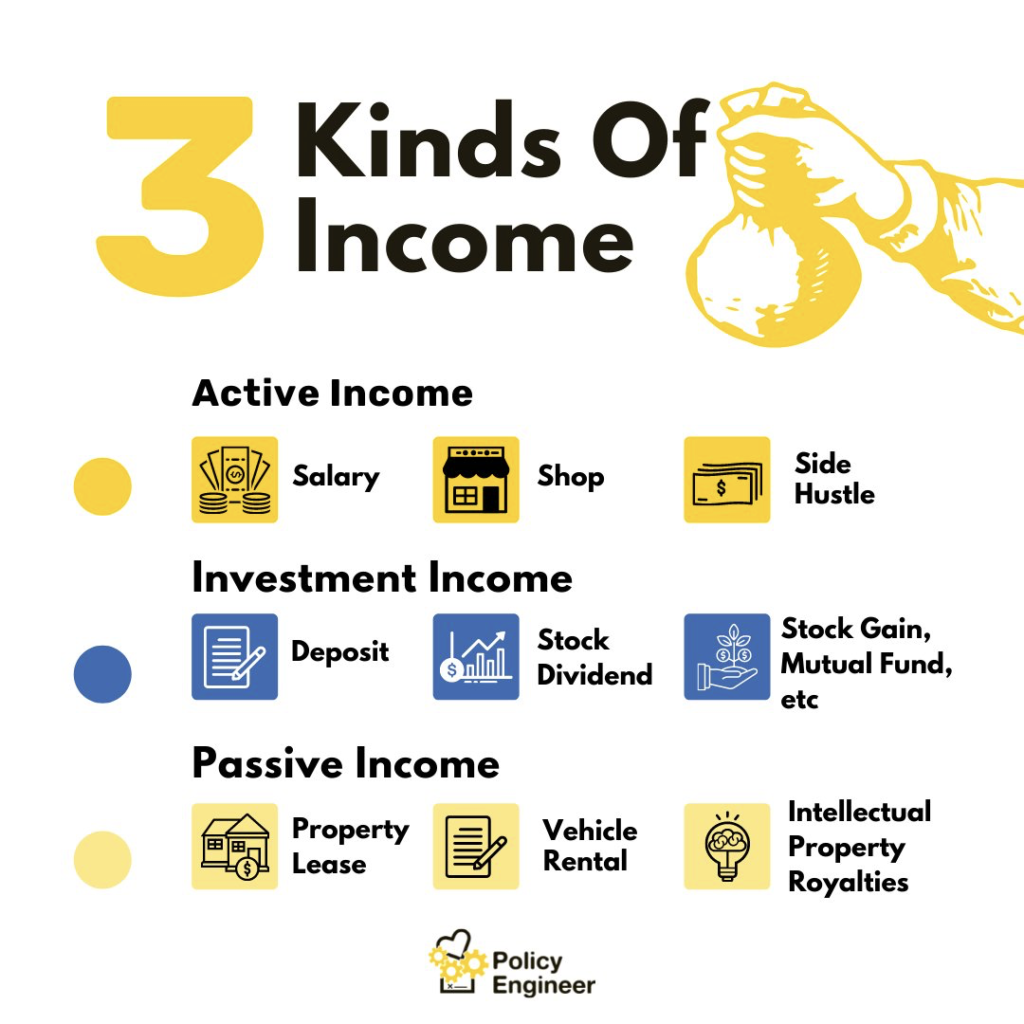
What is the difference between Passive Income and a Side Hustle?
Passive income and passive activities are not the same. Passive income refers to income that requires minimal ongoing effort or involvement to maintain, while passive activities refer to any activity in which the taxpayer does not materially participate.
Passive activities can generate passive income, such as from a rental property managed by a third party. However, not all passive income comes from passive activities, such as stock dividends or interest from bonds.
What is the difference between Passive Income and a Side Hustle?
While both passive income and side hustles are great ways of generating income, the main difference is that side hustles lack the ‘passive’ factor. The amount of money you can make off them is usually directly connected to the amount of time you can put in.
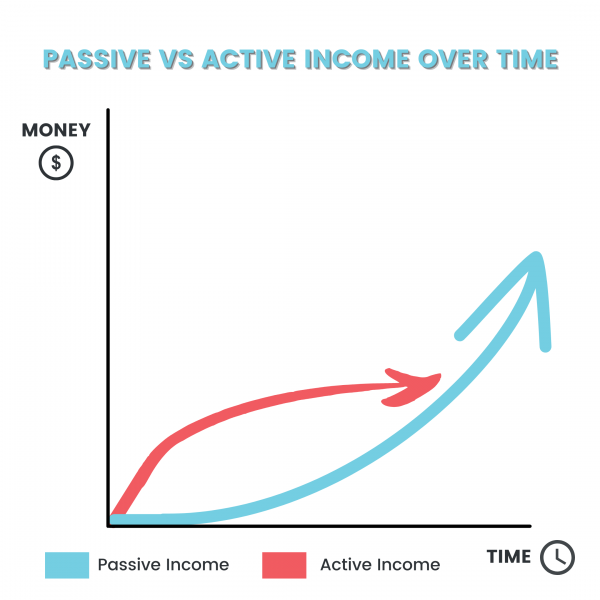
For example, let’s say you decide to use some of your nights after work to become an Uber driver to help you build up your income. There are still only 24 hours a day, and the amount you can earn from this will be capped by the available time. This type of side hustle is active income, as you have to be physically there to earn money.
Having said this, sometimes, these terms are used interchangeably. For example, many people consider starting up a small online store or an app as their side hustle. This is an excellent example of a side hustle and a passive income stream.
While it might take some serious time upfront to get these projects running, ultimately, these can make their money with little to no continuing effort.
How Should I Get Started With Passive Income?
Exploring passive income opportunities can be an excellent starting point for diversifying their income streams and achieving greater financial security. But before you start, consider these two questions:
1) How much time am I able to dedicate to my chosen passive income stream?
While you can go all guns blazing and try out every passive income idea simultaneously, it can quickly get overwhelming. The best approach is often to weigh up the different potential sources of income and choose just one or two that you think would be the best fit based on your skills, interests, and financial goals.
Focus on these as you get started, and once you feel comfortable with them, you can always venture into trying out more passive income options. Time will likely be a significant factor in your chosen passive income stream, as some require more upfront work than others.
2) What does my financial situation look like at the moment?
Before starting on your passive income journey is a great time to review your current financial standing quickly. In general, these are a few questions we’d recommend knowing the answers to before you get started investing in any passive income streams:
Am I bringing in more income each week than I am spending?
Many passive income streams will take a little while to bring in money. If you need short-term money to help bridge the gap between what you’re currently earning and spending, then an active side hustle such as picking up some extra hours at work, freelancing, or delivery driving might be a better idea in the short term.
If you realize your expenses currently outweigh what you’re bringing in each week, it also might be a good time to look at where you’re spending your money and if there are any areas you can cut back on.
Do I have any high-interest debt that will be more helpful for me to pay off first?
This one isn’t relevant for everyone, but with some quick maths, you can work out if it’s applicable. Let’s say I’m looking to invest some of my savings, to $1000, in a high-interest savings account or the stock market.
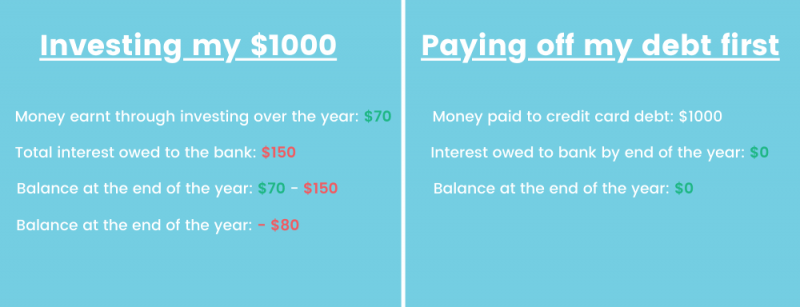
I would bring in 7% interest annually as a rough ballpark figure. If I currently have outstanding credit card debt or other personal loans charging me 15% interest per year, it quickly becomes clear why it would be essential to pay these off first.
So, before we go any further, think if there is any high-interest debt looming over you that is more beneficial to pay off first.
Most Popular Ways To Generate Passive Income
Many articles about creating sources of passive income contain similar ideas, making it difficult to know where to begin. To simplify things, I’ve compiled a list of the top 20 passive income articles featured on Google and ranked the most frequently mentioned ideas.
Despite many ideas, almost 60% were simply reiterations of the top eight. In the following section, we’ll explore these eight streams in greater detail and discuss the best ways to get started with each.
1. Selling Digital Products
4. Invest in the Stock Market
7. Affiliate Marketing
3. Invest in Real Estate
6. Start A Blog Or Youtube Channel
More Passive Income Ideas
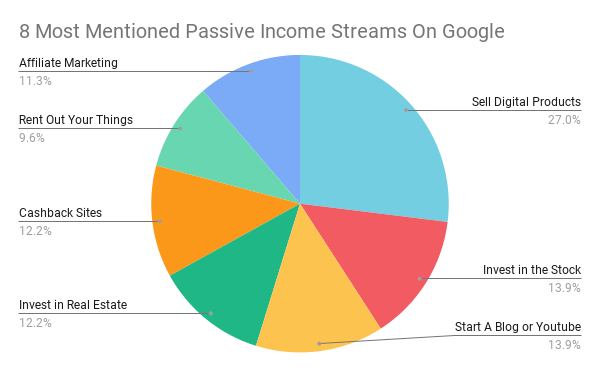
1. Selling Digital Products
This idea is splattered all over the internet. The concept behind all of these iterations is the same, including everything from starting online courses to writing e-books to selling t-shirt designs. Harness the skills you already have and monetize them using popular platforms.
Whether it be graphic design or other hard skills that you use in your day job, if there is a niche you feel you have a lot of specific knowledge about, then this passive income idea could be an excellent match for you. Let’s dig deeper into what each of these ideas could entail.
Selling designs on print-on-demand stores
Print-on-demand requires you to provide custom graphics, and then you can print and sell your designs on t-shirts, mugs, calendars, and any other physical product you can imagine.
While the margins you make usually aren’t exceptionally high, most of the common platforms take care of the bulk of the logistics for you, so it can be effortless to get started.
The most popular Print On Demand platforms are:
Creating an Online Course
When considering online courses, a few standard ideas come to mind: Excel skills, learning another language, or learning how to start a small business. However, the internet has allowed for the exchange of every kind of skill.
I’ve seen people get creative with the courses they’re creating, and you can too! Think of everything from ‘How To Make Your Cat Instagram Famous’ to ‘Hypnosis 101’.
The most popular platforms to distribute your online course are:
- Udemy
- Skillshare
- Khan Academy
- Learnworlds
- LinkedIn Learning (formerly called Lynda)
- Thinkific
- Kajabi
- Udacity
Writing an eBook or Audiobook
You’re probably not a stranger to your favorite influencers or authors coming out with an eBook or audiobook. The great thing about this option is the flexibility. Just because it’s called an eBook doesn’t mean you have to follow a traditional format.
Many eBooks are short or written as a step-by-step guide. If you already have the knowledge and passion for a topic you’re interested in, there’s no harm in jotting it down and giving it a go.
Once you have your eBook or audiobook all ready to go, you could set up a website of your own, or you can consistently distribute it through:
2. Rent Out Your Things
Most people are familiar with the idea of the sharing economy, and for most, using apps like Uber, Airbnb, and Postmates is part of their weekly routine.
What is less talked about when it comes to the sharing economy is the untapped earning potential many people have from things they already have at home. There are so many examples of different ways you can rent out your belongings, but here are a few of our favorites to get you started:
Make Money From Your Unused Driveway, Garage or Car Spot
This one is close to our hearts! You can make up to $450 a month by renting out space at home. Spacer connects you to locals in your area who need parking, including in Boston, Chicago, Dallas, Los Angeles, New York, San Francisco and other locations across the country. Find out more about becoming a host.
Related: Rent My Parking Spot. Earn Up To $450 Per Month Renting Out Your Empty Parking Spot
Make Money Off Your Car
This was the most common idea I saw in other articles. The ideas for doing so varied, but the concept was the same. Our cars spend most of their life parked and make up a considerable expense for most people, so if you can get your car to make money for you, it’s a win-win.
- Rent out your car without using it with sites like Turo or Getaround.Make money by allowing advertisers to display their ads on your car through platforms like Carvertise and Wrapify.
Make Money Off Your House
This was another popular suggestion for those who own or rent a property. Here are a few ways you can consider making extra money off of your house:
- If you have a spare room, consider renting it out through AirBnb, Vrbo or Booking.com.
- Make money from your backyard. Sites like Nookzy allow you to rent out your backyard for small events and gatherings. You can easily spread the word by creating an event flyer and sharing it with your family, friends and upload it online to get more reach.
Make Money Off Your Boat or RV
The reality of being a boat or RV owner is that you’re likely not to use these vehicles every weekend. Marketplaces like RVShare, GetMyBoat, and Boatsetter connect you to people who want to rent your RV or boat for short-term use.
Make Money Off Of Your Surfboard, Skiing Or Snowboarding gear
Similar to these above, it’s unlikely you’d be able to go skiing or snowboarding every weekend. You can share your surf, bike, or snow gear with like-minded travelers and locals through platforms like Spinlister.
Make Money Off Of Anything Else
If nothing on this list has sparked your interest so far, don’t worry. Sites like FriendWithA allow you to rent almost anything you have at home, from tools to kitchenware to instruments and exercise gear. You’d be surprised at what people are looking to rent!
Related: Earn Passive Income From The Sharing Economy With These 21 Tips
3. Invest in Real Estate
For most, owning multiple properties might seem like a distant dream, but there are more ways to get into the property market than often meets the eye. When people talk about investing in real estate, we usually jump straight to owning a rental property.
Still, there are many more accessible ways to invest in real estate if that’s not within your budget. Two ways include real estate investment trusts (REITs) and crowdfunded real estate.
REITs
You’re probably asking, what is a REIT anyway? A Real Estate Investment Trust is a company that owns real estate designed to generate revenue. This could include anything from apartment complexes to office buildings to warehouses. They allow many investors to buy into their company and disperse some of their profits through dividends.
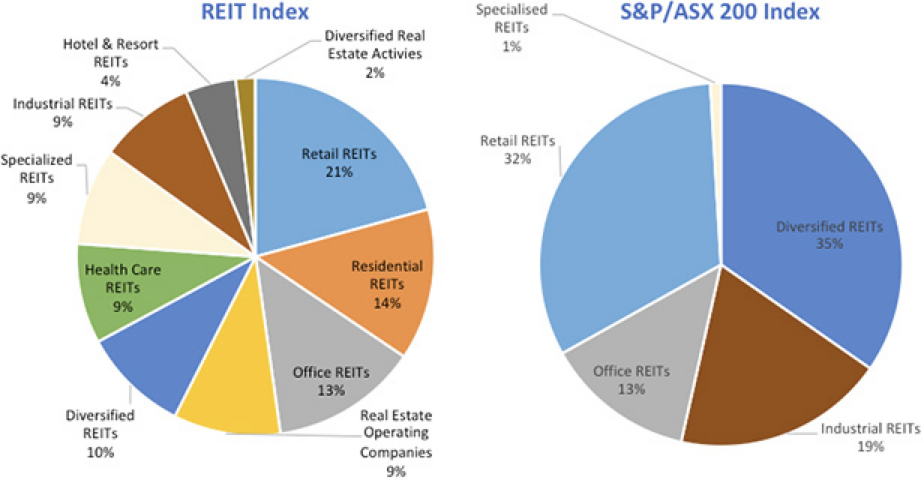 This makes it possible to invest in real estate without purchasing a whole property and functions similarly to the stock market, allowing for buying and selling. There are several types of REITs, and you can purchase most of them through an ordinary brokerage account.
This makes it possible to invest in real estate without purchasing a whole property and functions similarly to the stock market, allowing for buying and selling. There are several types of REITs, and you can purchase most of them through an ordinary brokerage account.
Crowdfunded Real Estate
The idea behind crowdfunded real estate is simple. These platforms enable investors to pool their money together to invest in development projects that otherwise might not have been accessible.
The concept has exploded over the last few years, with many options popping up. Many of these platforms also offer their own private REIT option for investment.
The most common platforms currently seem to be:
The minimum investments between platforms vary greatly, with some sites like Fundrise and PeerStreet starting at $1,000 and others, such as CrowdStreet, starting at $25,000.
Related: Can I Airbnb my Apartment? Common Renting Questions Answered
4. Invest in The Stock Market
Investing in the stock market is often synonymous with making money passively, and it shouldn’t be a surprise that this is one of the most suggested ways to build passive income.
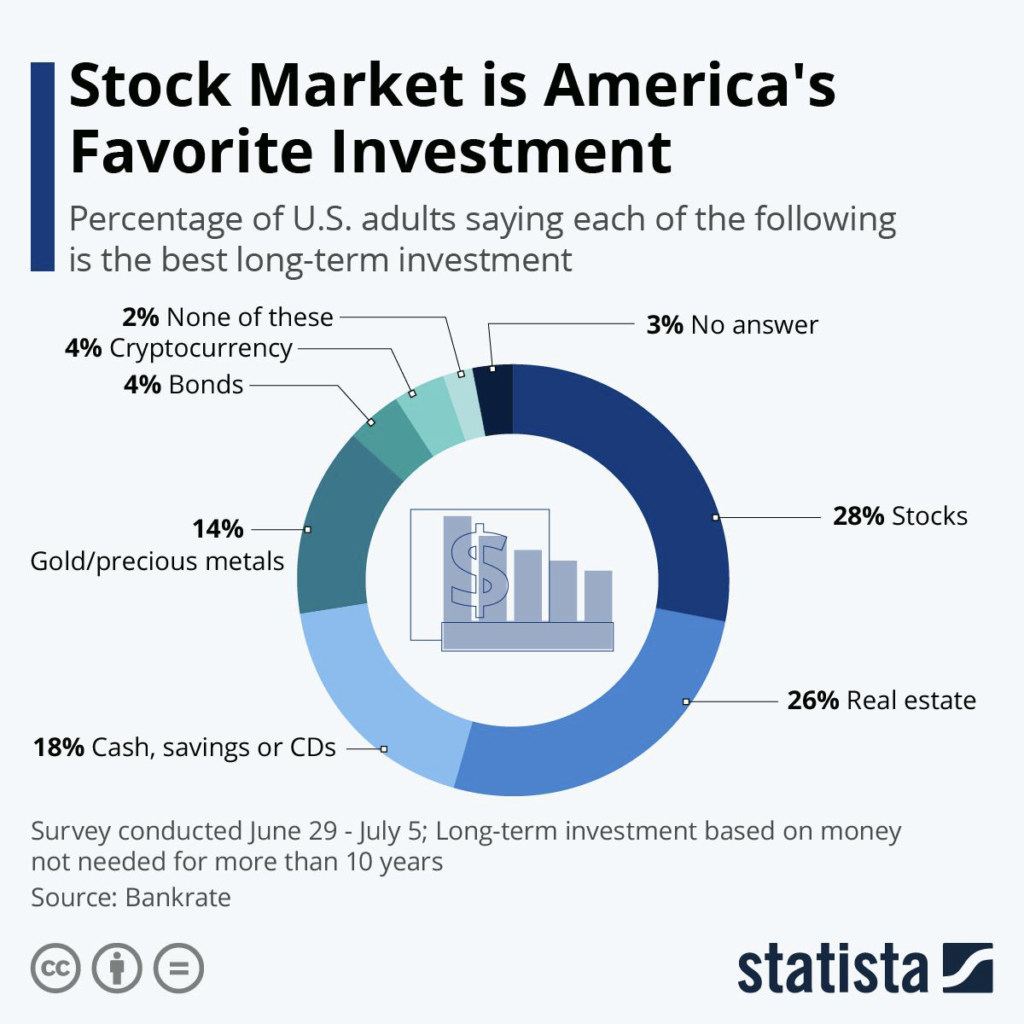
Image credit: Statista
There are two very distinct tactics for those investing, with some choosing to invest in dividend stocks and others opting to invest more passively and hold a more diversified portfolio, thereby generating portfolio income.
Passive income from investments such as stocks and real estate can significantly supplement your earnings. Income from these investments can be subject to capital gains taxes, affecting overall earnings and financial planning.
Working with a knowledgeable financial advisor can help you understand the tax implications of different passive income streams and develop a strategy to optimize your earnings while minimizing your tax burden.
Investing in Dividend Stocks
This first approach largely centers around purchasing stocks with a history of paying shareholders a high quarterly dividend.
Investors will specifically pick out companies that focus on paying high returns to their investors, and by doing this at a large scale, they can essentially build another income stream. They then can reinvest this money into the stock market or keep it to spend.
Investing in Index Funds or ETFs
This strategy is usually more long-term focused and theoretically “set and forget.” Exchange-traded funds (ETFs) or index funds can be an excellent option for those that don’t feel confident picking out individual stocks to invest in. ETFs are a mixed goodie bag of different assets and can be traded like regular stocks.
Index funds are a fund meant to mirror the performance of a particular market index, for example, the S&P 500. They have the same investing goal, to diversify everything you’re investing in, but they have different approaches.
How To Invest In The Stock Market?
While there are many ways to begin investing in the stock market, such as investing in your employer’s 401K or getting someone to manage your finances, many people also opt to manage it online.
If you decide that is your best approach, many online brokerages give you access to the stock market. For example, some low-fee options include:
Related: Earn Passive Income From The Sharing Economy With These 21 Tips
5. Use Cashback Sites
The appeal behind this passive income stream is that you can make money doing things you already do. From your groceries to online shopping, many apps have a wide range of partners who offer different deals and cashback offers on your purchases.
Many sites offer rewards for shopping and other online activities, such as taking surveys and watching video ads. The trick to these is to select one program you want to be loyal to and stick to that, as it can be time-consuming trying to keep track of many different offers across different sites.
Other shoppers hunt for the best offers based on large purchases they’re making and worry less about tracking smaller purchases. The most common cashback sites to use are:
Remember to look into a few things to help you select the site you want to go with. Firstly, what points do you have to reach to get paid? Most sites won’t let you see your first deposit or gift card until you’ve accumulated enough points. It’s always worth checking what that limit is before you sign up.
The other thing to remember is how often you’ll get paid and how easy the process is to apply for your cashback. Some sites do it automatically, but with others, there seem to be a lot of hoops to jump through, and it’s easy to miss out on the cashback for an item you’ve purchased if you aren’t aware of every step.
If cashback sites are too labor-intensive for you, there are often many ways to earn cashback automatically through your bank or credit card. For example, with Juno, you can enjoy 5% cash back at 5 brands of your choice, including Amazon, Netflix, Walmart, and many more.
If cashback sites are too labor intensive for you, there are often many ways to earn cashback automatically, through you bank or credit card. For example, with OnJuno, you can enjoy 5% cashback at 5 brands of your choice, including Amazon, Netflix, Walmart and many more.
6. Start A Blog or Youtube Channel
There were three distinct options mentioned here that we’ll have a bit of a deeper look into. The first is starting a blog yourself, the second is buying an existing blog, and the third is starting a YouTube channel.
Starting A Blog
I was shocked at how common a suggestion this was. However, it makes sense with 572 million blogs across the internet and some serious money to be made in the industry. While you can start a blog for free, many sites will require a small fee to cover your hosting and domain fees, so it’s good to ensure you have at least $100 to $200 set aside for this before you get started.
The next step is to start brainstorming your brand and blog name. What are the topics that you’ll write about? Is this something that a lot of people are already covering? What unique angles can you add to your content to make it stand out?
After deciding on a niche or category you feel comfortable writing about, it’s time to choose a platform. If you already have an existing audience on a site such as LinkedIn, you can often create your articles straight from the platform.

Image credit: Ghost
This will help you continue growing your reach and building a dedicated following. Otherwise, the most common sites to get started on are:
Medium differs slightly from the other options, as it’s an open platform – almost like a content marketplace. This might be a perfect choice if you’re just starting and looking to build a name for yourself, as there’s no pressure to create a website.
Buying A Blog
This approach is less common but definitely on the rise. Online ‘real estate’ is only increasing in value, and more people are becoming conscious of how lucrative a good-performing website can be. Thus, leading to the practice of ‘flipping’ blogs.
A handful of veteran bloggers realized that buying undervalued blogs with an existing community was a great opportunity. They can then continue creating blog content and reap the rewards through display ads, affiliate links, and sponsored posts.
They can then sell this blog to others when they feel they’ve capped out its potential. This strategy can be intimidating if you’re a first-timer, but with so much quality information, it can be a great way to enter the blogging world without building anything from the ground up.
Starting A YouTube Channel
The cat is out of the bag regarding the high-flying lifestyles of some top YouTubers. Did you know 75% of kids aged 6-17 now list ‘YouTuber’ as their dream career?
So, has the boat sailed? Or is this still a potential option for earning passive income?
The platform is undoubtedly more saturated than a decade ago, but that doesn’t mean there isn’t an opportunity. The amount of people consuming YouTube content continues to steadily increase, with more than a billion hours of content consumed daily. Before making the call, here are some questions to consider if this path is right for you.
1) Do you have access to quality recording equipment?
Gone are the days when a pixelated webcam could do the job. With a decent production quality of your videos, seeing success on the platform will be possible.
If you have access to a decent camera, microphone, lights, and editing software, you should have everything you need to get started.
2) Do you feel comfortable in front of a camera?
This is a big one! For most people, being in front of the camera does not come naturally, and while you can improve over time, it helps if you naturally have a knack for it.
If you’re seriously considering YouTube, consider recording practice videos and getting your friends and families’ opinions before investing significant time and money.
3) Is there a niche you can break into?
Like most passive income ideas, the main problem you’ll likely face is attracting an audience. With so much content being uploaded to the platform daily, you must feel confident that you have something unique.
Whether it be the editing style of your videos or the topics you touch on, there’s no harm in thinking out of the box. There’s so much content to be inspired by, so don’t forget to research first.
7. Affiliate Marketing
The concept of earning a commission by referring people to a business is familiar. Affiliate marketing is applied to the digital world. You’ve undoubtedly heard of bloggers making some serious cash through affiliate links. While it’s undoubtedly a more well-known career path now, it’s still possible to begin making money off of affiliate links for yourself.
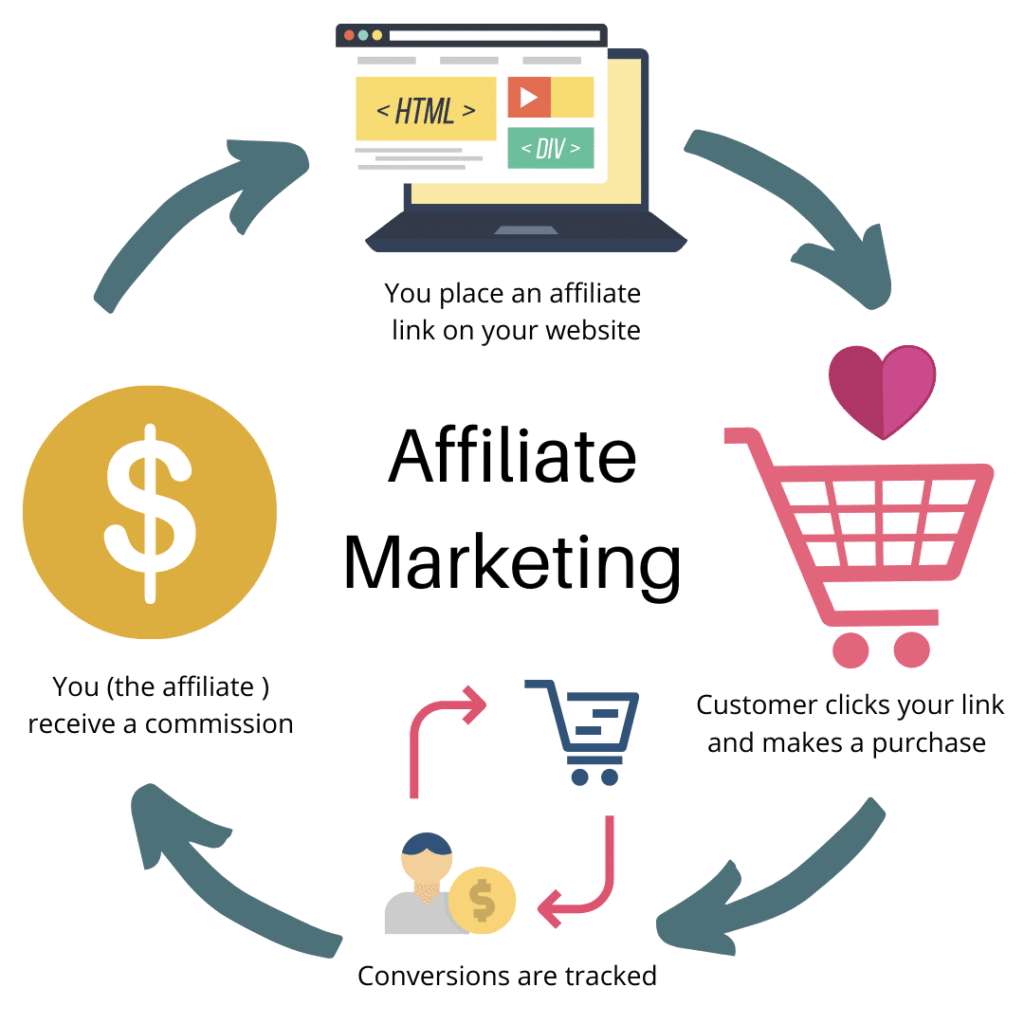
This idea is closely connected to the steps to building a blog we mentioned. To become trusted by sites as a referrer, it’s essential to begin building an engaged audience and have a clear niche where your knowledge is trusted. Once you’re well on the way to that, you can begin signing up for affiliate programs and making money every time someone from your audience purchases something through your link.
The most well-known affiliate marketing program is Amazon’s Associates, where you can earn up to 10% for each sale you help them make. However, many other prominent programs are worth signing up for if affiliate marketing is your best passive income stream. These include:
There’s generally no set rule for how many followers you need to qualify for these programs. Most affiliate programs are pretty hush-hush with the criteria they use to select those that get into their programs. In addition, none of the providers shared platform preferences, e.g., if you bring traffic from YouTube, Instagram, an e-commerce website, or your blog.
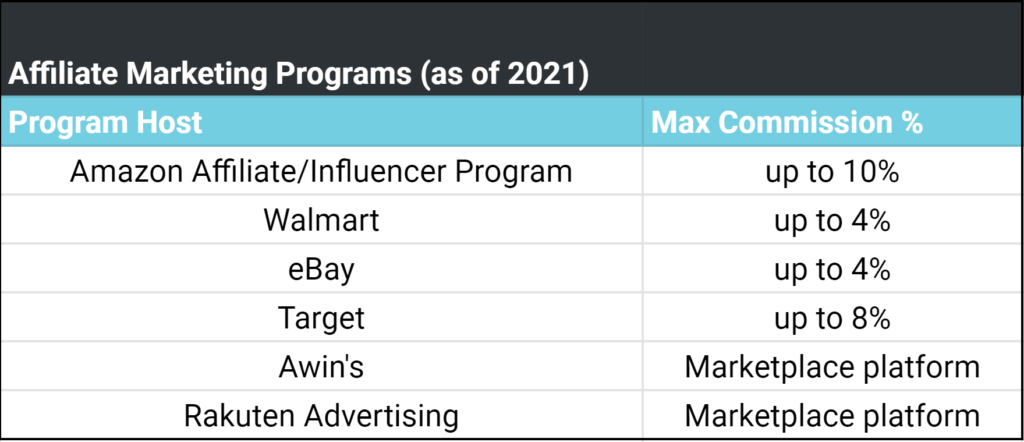
They have several different streams when signing up for eBay’s Partner Network. Select the most relevant to you, e.g., a social media influencer or a shopping comparison site. It appears that for most sites, each application is reviewed individually. The main criteria they call out is that your content has to be ‘family friendly’ and not violate any of their terms of use.
The last two options are different in terms of setup. Rather than giving you access to one advertiser, these sites function as a Marketplace and give you access to apply to an extensive range of other individual advertisers. The rates you can expect to make vary hugely by the programs you apply for and are selected into.
8. Create An App
While this option may seem like a lot more upfront work than some of the other passive income ideas, it can be highly lucrative if you have the skill set. If there’s a need that you’ve identified or even something fun you think people would enjoy, then bringing it to life is the next best step.
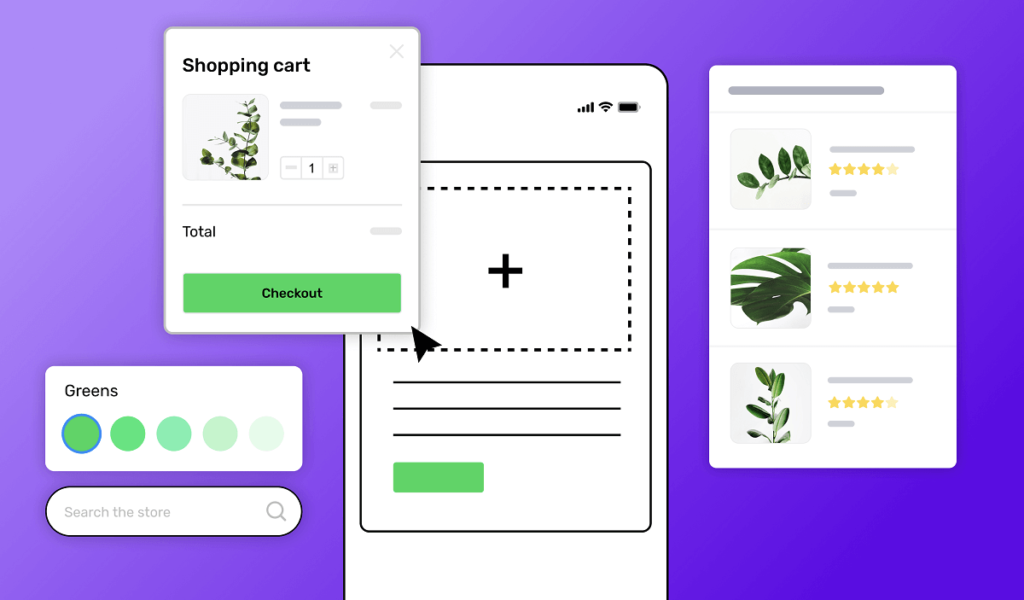
Even if there is an existing app for a concept, it might be worth putting your hat in the ring. The thing that makes building an app truly passive is that once you’ve created the application itself, it can often take very little maintenance.
Plus, if it’s a hit, it can bring in an enormous amount of sustainable revenue. For example, the top apps earn, on average, $82,500 daily. There are a few different ways that you can monetize your app.
For example, you can make it a pay-to-download app, or like many others, you can make it free to download but charge either a one-off or subscription fee to upgrade to a premium account and access more features or turn off ads. The other popular option for monetizing ads includes having a free app but using advertising through ads to earn revenue.
If you are developing an app solely by yourself from start to finish, there are few initial investments compared to hiring an app developer. However, you need the right software, a good computer, and in-depth coding and user testing knowledge.
Another option is an online app builder, which can range anywhere from $10-$1000+ monthly. The last thing you’ll need to consider is buying a developer’s license if you don’t already have one. Apple’s App Store License will set you back $99, whereas you can expect to pay $25 for the Google Play Store equivalent.
9. More Passive Income Ideas
While the previous eight ideas made up a bulk of the highly recommended passive income ideas, we do have a few honorable mentions.
Investing in an Established Business
While this can certainly be high risk, the idea behind it is similar to investing in the stock market without the middleman and with smaller companies. For example, platforms like Mainvest and Seedrs are equity crowdsourcing platforms that connect investors to small businesses looking for capital. Given the high risk nature of this type of investing, Seedr and many other sites have a pretty severe eligibility criteria to help them make sure you know what you’re doing.
Peer-to-Peer (P2P) Lending
Investing in peer-to-peer lending is the equivalent of becoming a bank for others. Platforms match those looking for loans with a lower interest rate than banks with investors like you, who are looking to make a return of roughly between 5% and 7%. The expected return and fees the platform charges vary from provider to provider so it’s worthwhile doing more research, but some of the most popular platforms are Prosper, Worthy Bonds and FundingCircle.
Sell Your Photography
This is for all you budding photographers out there! If you’ve got high quality images that you’re looking to make money off of, there are a whole array of stock photography sites where you can license out your images. While the rates can be pretty low, it can pay off if you have a large portfolio of images or take product/brand specific photography. Some sites to check out include Shutterstock and iStock.
Resources To Get Started With
While the previous eight ideas comprised the most highly recommended passive income ideas, we have a few honorable mentions.
Investing in an established business
While this can certainly be high risk, the idea behind it is similar to investing in the stock market without the middleman and with smaller companies. For example, platforms like Mainvest and Seedrs are equity crowdsourcing platforms that connect investors to small businesses looking for capital.
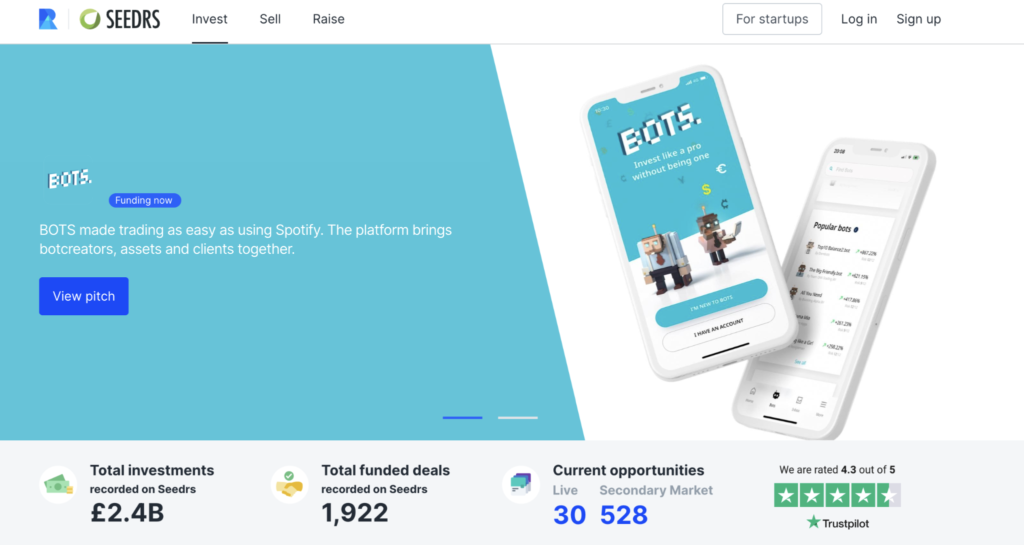
Image credit: Seedrs
Given the high-risk nature of this type of investing, Seedrs and many other sites have strict eligibility criteria to help them make sure you know what you’re doing.
Peer-to-peer lending
Investing in peer-to-peer (P2P) lending is the equivalent of becoming a bank for others. Platforms match those looking for loans with a lower interest rate than banks with investors like you, who want to make a return of roughly 5% and 7%.
The expected return and fees the platforms charges vary from provider to provider. Hence, it’s worthwhile doing more research, but some of the most popular platforms are Prosper, Worthy Bonds, and Funding Circle.
Crypto staking
Crypto staking is a process that involves holding a certain amount of cryptocurrency in a digital wallet for a specified period to earn rewards, similar to earning interest on a savings account. While it can be an effective way to earn passive income and often provide higher returns than traditional savings accounts, it has risks.
Recent events have highlighted the potential dangers of staking with peer-to-peer lending companies, such as Celsius and BlockFi, which collapsed due to poor risk management practices.
Investors who engage in crypto staking with these platforms may risk losing their principal investment. Conducting thorough research and carefully evaluating the risks involved before participating in a financial investment is essential.
Sell your photography
This is for all you budding photographers out there! If you’ve got high-quality images that you’re looking to make money off of, there are a whole array of stock photography sites where you can license your images.
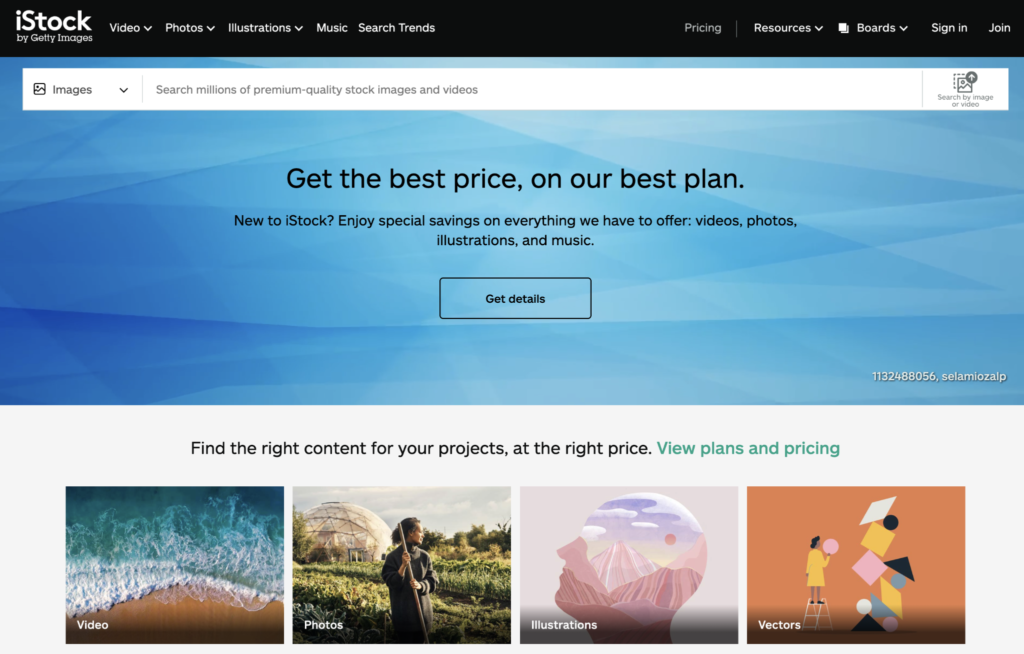
Image credit: iStock
While the rates are low, they can pay off if you have an extensive portfolio of images or take product and brand-specific photography. Some sites to check out include Shutterstock and iStock.
Resources to get started with
If you’re at a loss for where to start, here are a few of our favorite places and people to learn more about passive income and the ideas we discussed in this article.
Reddit Communities
Podcasts & Websites
Books
- The Four Hour Work Week by Tim Ferriss
- Your Money Or Your Life by Vicki Robins
- I Will Teach You to Be Rich by Ramit Sethi
- The Millionaire Next Door by Dr. Thomas J. Stanley
- The Richest Man in Babylon by George S. Clason
- Rich Dad Poor Dad by Robert T. Kiyosaki
- The $100 Startup by Chris Guillebeau
- Motivated Money by Peter Thornhill
Youtube Channels
Final Thoughts
There’s no one right choice for everyone regarding passive income. We hope this article sheds some light on the potential options and gets you thinking about which ones are the best for you.
If you have an unused garage, driveway, or car park, you can sign up as a host on Spacer.com. It’s super easy to start and is a great way to make extra monthly money from something you already have at home.
Disclaimer: The advice in this article is general and doesn’t consider your objectives, financial situation, or needs. Please consider whether this advice is right for you, based on your needs and financial situation, and seek professional financial advice if you need further personalized guidance.
All information about performance and rates of returns mentioned throughout this article is historical. They shouldn’t be relied on as an indicator of performance in the future, as investments can always rise or fall in value. The views and opinions expressed in this piece are my personal views and don’t necessarily reflect the views of Spacer.





